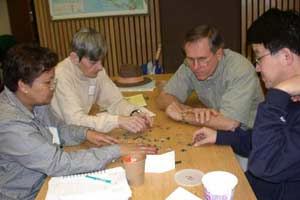|
|
||
Stressing the Nature of Science
|
||
Reviewing Energy Transfer, Transportation and DepositionErosion is the process through which surfaces of rocks and soil are loosened and then transported elsewhere. But where does all of that sediment go? This series of slides illustrates the nature of San Francisco Bay as a depositional basin. The San Fransisco Bay as an Energy
Review |
||
Stratigraphy - Timing Events in the Past
|
||
Stories from the Fossil RecordThe fossil record provides concrete evidence of the history of life and the processes through which it has evolved. The clues are numerous and can be interpreted by comparing an entire assemblage of fossils, a single fossil, or even the traces left by past life.
|
||
The Importance of VariationVariation exists among individuals within species. Variation leads to different "survival" rates, which leads to changes in frequencies in a population, which is evolution.
|
||
Looking at the Big IdeasDiscussion: Identifying the evolution concepts |
||
Additional ResourcesUnderstanding Geologic Time: This web-based module introduces students to geologic time, the evidence for events in Earth's history, relative and absolute dating techniques, and the significance of the geologic time scale. Getting Into the Fossil Record: This web-based module helps students gain a basic understanding of what a fossil is and how a fossil forms. Stories from the Fossil Record: This web-based module provides students with a basic understanding of how fossils can be used to interpret the past. There are four different pathways to explore: biodiversity, geologic time, paleoecology and past lives. How Big is a Billion? Most people have a difficult time comprehending the enormity of the numbers involved in discussions of geologic time. These exercises help students to better understand what "a billion" really means. |
||
| Updated January 5, 2003 Home | What's new | About UCMP | History of Life | Collections | Subway |

